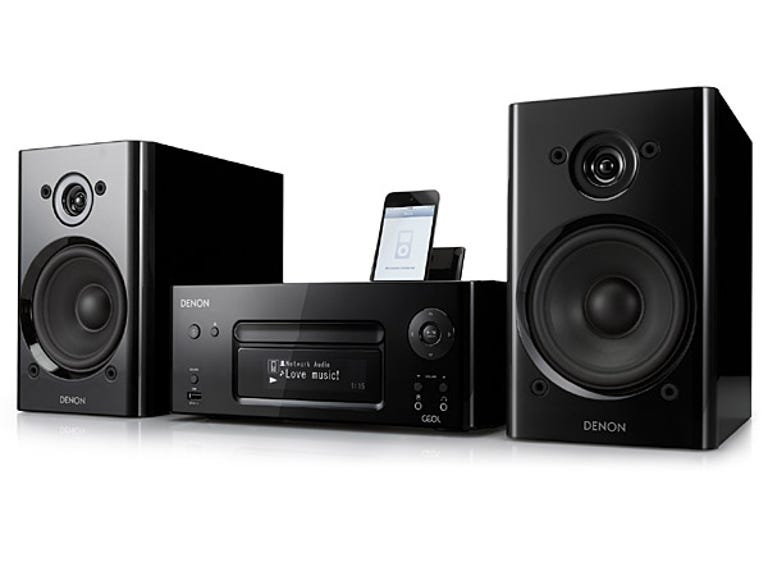 Why You Can Trust CNET
Why You Can Trust CNET Denon CEOL RCD-N8 review: Denon CEOL RCD-N8
The Denon CEOL is a well thought out compact stereo, providing good quality from a wide range of sources, including your network and the internet.
The Denon CEOL is a well thought out, compact stereo system providing good-quality music from a wide range of sources, including your network and the internet.
The Good
The Bad
The Bottom Line
Hardware
The Denon CEOL network audio system is a compact, decent-quality stereo system that includes a CD player, FM radio, iPod dock and digital media player for USB and network content. Your AU$1000 gets you three components: two compact loudspeakers and one main box of electronics, plus a remote control. You have a choice of gloss black or white.
The main electronics unit provides a stereo amplifier with a built-in CD player, FM radio tuner and a range of network functions. There's an iPod/iPhone dock on top — using the old 30-pin connection, so for newer Apple devices, you'll need a Lightning adapter. You can't use the dock for an iPad, since the connector is recessed. iPads, new iPhones, iPod Touches and iPod Nanos can be plugged in, using their own cables, to the USB socket at the front. This USB port delivers enough oomph to charge an iPad. Or you can use that USB socket for music from any mass-storage media device.
Networking can be wired or Wi-Fi. The unit provides all of its visual feedback via the front display panel — there is no video output option for controlling the device via your TV. The network functionality supports Apple AirPlay, access to audio on your network via DLNA protocols, use of the Denon remote app on both iOS and Android devices and, of course, internet streaming services.
One of those services, Last.fm, won't work in Australia without manipulating your network location settings in some way. The other two, vTuner-based Internet Radio and the Spotify subscription music service, both work here.
Denon has made getting the system up and going easy. Taking notes from Apple, it seems, you open the carton and find right at the top a clearly laid-out pamphlet labelled "Start Here". The full manual is provided in the unit on a CD ROM if you need more detail.
Audio
Initially, this system sounded very strange indeed. It was unfocused, without clear localisation. Any experienced listener would recognise what was going immediately: the speakers were out of phase with each other. That is, the "positive" terminal on one, but not both, was connected to the "negative" terminal on the amplifier. So if you feed a mono signal to the stereo system, while one speaker cone is pushing out, the other one is pulling in, instead of them working together.
The solution is simple: reverse the "positive" and "negative" connections for one of the speakers at just one end of the cable. I did that, and the sound was as it should have been. It turned out the problem was with the supplied speaker cables. One had the polarity marker on one end of the cable on the wrong conductor. I'd suggest you toss these flimsy cables and spend a few dollars on proper speaker cables.
With AU$20 worth of decent quality cables in place, this proved to be one nice-sounding system. Smooth, with good stereo imaging and reasonable volume levels available. It will go quite loud in a small enough teenager's bedroom, and moderately loud in a regular lounge room. The tonal balance was very even, so there was little colouration to the sound. Only with some loud rock did it seem a bit limited; complex passages, such as with King Crimson, became a bit confused at high levels. The main weakness of the system's sound is the low sensitivity of the speakers. They're rated at 82dB. Many compact speakers will give 6 decibels or more of volume for the same watt of power.
The bass is clean and balanced in the mid-section, but starts to roll off below about 70 hertz.
You may want to use the optical digital audio input on the unit with your TV's matching output. That's a good use, since this system sounds much better than any TV. But take a moment to go into your TV's menus, and switch its digital audio output to PCM. Not Dolby Digital. The unit will not decode Dolby Digital sound, so if you don't make that change, there will be no audio from the likes of One and Gem HDTV stations.
The unit does support high-resolution (96kHz, 24-bit) PCM via optical digital audio, as well as high-resolution formats via USB. That includes both WAV and FLAC at up to 192kHz, 24-bit, in addition to the more usual MP3, WMA and MP4, including iTunes-style .m4a files.
Spotify provides decent quality and a magnificent range if you have a Premium subscription (AU$11.99 per month), with very little you can't find there. vTuner is free, and is best used by setting up your favourite stations from the tens of thousands available via a web browser. That makes for ready selection from the unit.
Conclusion
Denon has engineered this system extremely well to provide good-quality sound with wide media access at a reasonable price. It also offers an upgrade path. Just add higher-quality loudspeakers for better (and louder) sound, or plug in an active subwoofer for deeper bass.


